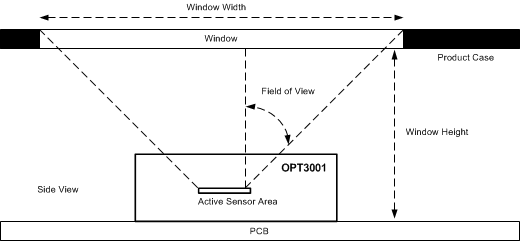SBOS853A March 2017 – December 2018 OPT3001-Q1
PRODUCTION DATA.
- 1 Features
- 2 Applications
- 3 Description
- 4 Revision History
- 5 Description (continued)
- 6 Pin Configuration and Functions
- 7 Specifications
-
8 Detailed Description
- 8.1 Overview
- 8.2 Functional Block Diagram
- 8.3 Feature Description
- 8.4 Device Functional Modes
- 8.5 Programming
- 8.6
Register Maps
- 8.6.1
Internal Registers
- 8.6.1.1
Register Descriptions
- 8.6.1.1.1 Result Register (offset = 00h)
- 8.6.1.1.2 Configuration Register (offset = 01h) [reset = C810h]
- 8.6.1.1.3 Low-Limit Register (offset = 02h) [reset = C0000h]
- 8.6.1.1.4 High-Limit Register (offset = 03h) [reset = BFFFh]
- 8.6.1.1.5 Manufacturer ID Register (offset = 7Eh) [reset = 5449h]
- 8.6.1.1.6 Device ID Register (offset = 7Fh) [reset = 3001h]
- 8.6.1.1
Register Descriptions
- 8.6.1
Internal Registers
- 9 Application and Implementation
- 10Power Supply Recommendations
- 11Layout
- 12Device and Documentation Support
- 13Mechanical, Packaging, and Orderable Information
Package Options
Mechanical Data (Package|Pins)
- DNP|6
Thermal pad, mechanical data (Package|Pins)
Orderable Information
9.2.2.1 Optomechanical Design
After completing the electrical design, the next task is the optomechancial design. Design a product case that includes a window to transmit the light from outside the product to the sensor, as shown in Figure 34. Design the window width and window height to give a ±45° field of view. A rigorous design of the field of view takes into account the location of the sensor area, as shown in Figure 41. The OPT3001-Q1 active sensor area is centered along one axis of the package top view, but has a minor offset on the other axis of the top view. Window sizing and placement is discussed in more rigorous detail in application report SBEA002, OPT3001: Ambient Light Sensor Application Guide.
 Figure 34. Product Case and Window Over the OPT3001-Q1 Device
Figure 34. Product Case and Window Over the OPT3001-Q1 Device